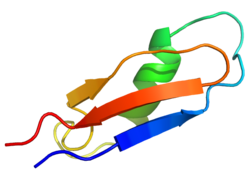Chemistry:Ssm spooky toxin
| Spooky toxin | |
|---|---|
 3D structure of spooky toxin | |
| Identifiers | |
| Organism | |
| Symbol | SsTx |
| PDB | 5X0S (ECOD) |
Spooky toxin (SsTx) is a small peptide neurotoxin. It is found in the venom of Chinese red-headed centipedes (Scolopendra subspinipes mutilans), also known as golden head centipedes. It is originally composed of 76 amino acids (sequence: MEKKIIFLVFLVAL LALPGFISTEVIKK DTPYKKRKFPYKSEC LKACATSFTG GDESRIQEGKPG FFKCTCYFTTG, disulfide bonds Cys43-Cys69, Cys47-Cys71), with a molecular weight of 6017.5 daltons, but loses the first 23 residues and becomes 53 residues long (sequence EVIKKDTPYKKRKFPYKSECLKACATSFTGGDESRIQEGKPGFFKCTCYFTTG, disulfide bonds Cys20-Cys46, Cys24-Cys48). SsTx is currently thought to be unique to Scolopendra subspinipes mutilans.
By blocking KCNQ channels (preventing potassium from flowing into and out of cells) SsTx disrupts cardiovascular, respiratory, muscular, and nervous systems; where snake venoms typically only affect circulatory or nervous systems, and venom from spiders, scorpions, and snails typically only target nervous systems. This allows for golden headed centipedes to target larger prey up to 15 times their size.[1]
Applications
The venom of the Scolopendra subspinipes mutilans is already being widely used as a traditional medicine in Asian countries.[2] Claimed medicinal uses include antimicrobial, antibacterial, and anticancer.[3][4][5]
See also
References
- ↑ "Centipedes subdue giant prey by blocking KCNQ channels". Proceedings of the National Academy of Sciences of the United States of America 115 (7): 1646–1651. February 2018. doi:10.1073/pnas.1714760115. PMID 29358396. Bibcode: 2018PNAS..115.1646L.
- ↑ "Insects and other arthropods used as drugs in Korean traditional medicine". Journal of Ethnopharmacology 65 (3): 207–16. June 1999. doi:10.1016/S0378-8741(98)00209-8. PMID 10404418.
- ↑ "Antimicrobial peptides in the centipede Scolopendra subspinipes mutilans". Functional & Integrative Genomics 14 (2): 275–83. June 2014. doi:10.1007/s10142-014-0366-3. PMID 24652097.
- ↑ "Induction, purification and characterization of an antibacterial peptide scolopendrin I from the venom of centipede Scolopendra subspinipes mutilans". Indian Journal of Biochemistry & Biophysics 43 (2): 88–93. April 2006. PMID 16955756.
- ↑ "Anticancer Activity of the Antimicrobial Peptide Scolopendrasin VII Derived from the Centipede, Scolopendra subspinipes mutilans". Journal of Microbiology and Biotechnology 25 (8): 1275–80. August 2015. doi:10.4014/jmb.1503.03091. PMID 25907065.
 |

